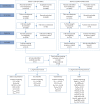Lung volumes, gas transfer and oscillometry after preterm birth: systematic review and meta-analysis
- PMID: 40436611
- PMCID: PMC12117382
- DOI: 10.1183/16000617.0151-2024
Lung volumes, gas transfer and oscillometry after preterm birth: systematic review and meta-analysis
Abstract
Background: Small airway and lung parenchymal abnormalities frequently occur following preterm birth but are commonly missed by spirometry. Static lung volumes, diffusing capacity of the lung for carbon monoxide (D LCO) and oscillometry provide a more precise characterisation of these conditions. We hypothesised that differences in these measures exist between individuals born preterm and at term and we aimed to systematically review the literature to identify and quantify these differences in lung function.
Methods: This systematic review and meta-analysis, registered with PROSPERO (CRD42022320775) and guided by Preferred Reporting Items for Systematic Reviews and Meta-Analyses standards, searched six databases up to 29 December 2024. We included studies comparing lung function between preterm subjects and term controls via static lung volumes, gas transfer or oscillometry. Differences in lung function were analysed using random-effects meta-analysis to compute the standardised mean difference (SMD).
Results: From 12 143 titles, we analysed 52 cohorts with static lung volumes, 37 with gas transfer and 18 with oscillometry data. While total lung capacity was similar between preterm and term cohorts (SMD -0.08, 95% CI -0.17 to 0.004), preterm participants showed increased residual volume (SMD 0.32, 95% CI 0.19 to 0.44) and residual volume/total lung capacity (SMD 0.45, 95% CI 0.28 to 0.63). D LCO was lower in preterm cohorts (SMD -0.51, 95% CI -0.64 to -0.38). Preterm cohorts also demonstrated increased airway resistance at 5/6 Hz (SMD 0.44, 95% CI 0.22 to 0.67), difference between airway resistance at 5/6 Hz and 20 Hz (SMD 0.51, 95% CI 0.07 to 0.96), resonant frequency (SMD 0.63, 95% CI 0.12 to 1.15) and area under the reactance curve (SMD 0.62, 95% CI 0.35 to 0.88).
Interpretation: We demonstrate that preterm birth is linked to notable abnormalities in static lung volumes, gas transfer and oscillometry, underscoring the necessity of employing comprehensive pulmonary function tests beyond spirometry to monitor and address long-term respiratory outcomes effectively.
Copyright ©The authors 2025.
Conflict of interest statement
Conflict of interest: The study authors declare no competing interests in this review.
Figures


Similar articles
-
Physiological responses to exercise in survivors of preterm birth: a meta-analysis.Eur Respir Rev. 2025 Jun 18;34(176):240163. doi: 10.1183/16000617.0163-2024. Print 2025 Apr. Eur Respir Rev. 2025. PMID: 40533101 Free PMC article.
-
Early developmental intervention programmes provided post hospital discharge to prevent motor and cognitive impairment in preterm infants.Cochrane Database Syst Rev. 2024 Feb 13;2(2):CD005495. doi: 10.1002/14651858.CD005495.pub5. Cochrane Database Syst Rev. 2024. PMID: 38348930 Free PMC article.
-
Non-pharmacological management of infant and young child procedural pain.Cochrane Database Syst Rev. 2023 Jun 14;6(6):CD006275. doi: 10.1002/14651858.CD006275.pub4. Cochrane Database Syst Rev. 2023. PMID: 37314064 Free PMC article.
-
Different corticosteroids and regimens for accelerating fetal lung maturation for babies at risk of preterm birth.Cochrane Database Syst Rev. 2022 Aug 9;8(8):CD006764. doi: 10.1002/14651858.CD006764.pub4. Cochrane Database Syst Rev. 2022. PMID: 35943347 Free PMC article.
-
Interventions for promoting habitual exercise in people living with and beyond cancer.Cochrane Database Syst Rev. 2018 Sep 19;9(9):CD010192. doi: 10.1002/14651858.CD010192.pub3. Cochrane Database Syst Rev. 2018. PMID: 30229557 Free PMC article.
Cited by
-
Physiological responses to exercise in survivors of preterm birth: a meta-analysis.Eur Respir Rev. 2025 Jun 18;34(176):240163. doi: 10.1183/16000617.0163-2024. Print 2025 Apr. Eur Respir Rev. 2025. PMID: 40533101 Free PMC article.
References
Publication types
MeSH terms
LinkOut - more resources
Full Text Sources
